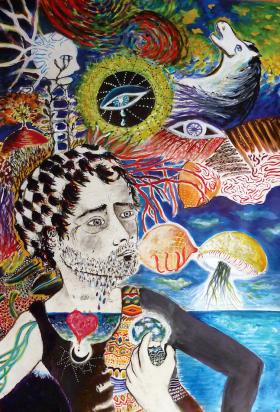Daphné Chevallereau et Eric Corne "Renverse du souffle"
Vernissage on Thursday 21 April from 6 p.m.
After Terre de Lune in 2014, Polad-Hardouin gallery is delighted to present Daphné Chevallereau’s new exhibition Renverse du souffle, from 21 April to 21 May 2016. Co-curated with Patricia Dorfmann gallery, the exhibition will include two paintings by Eric Corne, Daphné Chevallereau’s fellow painter.
The exhibition includes a dozen of pieces on paper and two recent large canvases, forming a highly coherent ensemble characterised by a painstaking work on textures (pencil, gouache, pastel and monotype). The title echoes one of her works (“Le souffle renversé”) and a poem by Paul Celan (“Renverse du soufflé”): “renverse” refers to emotional disturbance or the imaginary inversion of reality, and “souffle” to the inter movement that animates the works presented.
Heavily inspired by German expressionism and in particular by Beckmann, Chevallereau represents the individual in relation to an imaginary universe, down to its darkest aspects. Thus, in “Charon”, a military uniform is threatening with a weapon a young man on the foreground, who is imagining to flee toward a modern Ophelia, warded by Charon. The infernal ferryman standing by his boat is a recurring figure in several of the works presented: Chevallereau indeed keeps reworking several motifs from one drawing to the next, although her works are not conceived as a series.
The individual facing the world occupies a central place in her work, especially in terms of a woman’s relation to her own body and desires. Frida Kahlo remains a key reference for Chevallereau, and so are Myriam Cahn and Marlène Dumas. Thus, the female body is depicted from the most intimate perspective… Plant-women, sleeping women (“L'amour en parachute”), chandelier-women (“Lumière tressée”) and the pervasive presence of naked bodies: “I think that the expression of feminine desire takes place between modesty and unveiling”, she claims. The coloured patterns and textured materials around these women seem to emerge at once, as if born from a woman’s body.
The scenes represented on paper and canvas draw on the artist’s life, but without following an explicit narrative. The masculine figures lost in polychromatic landscapes could evoke a male archetype beyond the artist’s personal relationship with Eric Corne (“La mélancolie du corail”). The same goes for the religious symbols echoing one another from one drawing to the next: crosses, church candles and chalices partake in the polysemy of the works. Some motifs also remind us of artists admired by Chevallereau. For instance, the horse’s head in “Le souffle renversé” evokes some paintings by Chagall, and the church candle with its brightly coloured halo in “Lumière tressée” reminds us of Odilon Redon’s use of dry pastels as well as his themes. Beyond these references, her works therefore preserve a feeling of mystery that is accentuated by the words written backwards by the artist: a cipher that plays with visibility.
We find the same element of mystery in the work of Eric Corne, whose large canvas lends itself to different interpretations. “L'autodafé et ses lumières” presents a series of autodafé supervised by a skeleton and a naked woman, under the glaze of a painter standing outside of the frame, and in front of a long corridor depicted in perspective. Several sources of light radiate, as if corresponding to different point of views: church candles, a light bulb, a fire, a few neon lights. Hanging along the corridors are the painting that constitute Eric Corne’s imaginary museum. Symbols to be deciphered, energy, reflection on art and desire: as in the paintings of Chevallereau, there is no imposed narrative.
Daphné Chevallereau was born in 1988 and lives in Paris. She graduated from the École Nationale Supérieure d'Arts in Bourges. Renverse du souffle is her second exhibition at Polad-Hardouin gallery.
Eric Corne was born in 1959 and lives in Paris. He graduated from Beaux Arts in Tourcoing and from the École des Arts décoratifs in Paris. En 2001, he founded the art centre centre d'art Le Plateau à Paris, and curated several exhibitions in France and abroad. He is represented by the galleries Patricia Dorfmann (Paris), Nosbaum & Reding (Luxembourg) and Nicomède (Biarritz).
